NATURALIST NOTEBOOK MAY 12TH TO MAY 19TH
On May 12th we sailed out of Provincetown harbor with ideal conditions—clear skies, light wind and glassy calm seas. We saw a diversity of life with 1-2 finback whales, 1 gray seal, 24+ humpback whales and 100-175 Atlantic white-sided dolphins! Among our humpbacks were Dome, Backgammon, Pipette, Nazka, Orbit, Rapier and calf, Sockeye, Bolide and calf, Ganesh and calf, Fulcrum and calf and Reflection and calf. Many of the humpbacks were engaging in feeding behaviors such as kick feeding, whiles others were becoming curious of our boat! It is particularly important that mothers like Rapier, Bolide, Ganesh and Fulcrum get enough food to eat because there is a large energetic cost associated with nursing as large amounts of nutrients are transferred from the mother to her calf. As a result of the increase in maternal maintenance costs associated with lactation, it is common for there to be a large number of mother and baby whales on Stellwagen Bank, as there is often an abundant supply of sand lance. We look forward to re-sighting the calves and seeing them grow and acquire new skills such as practice kick feeding.
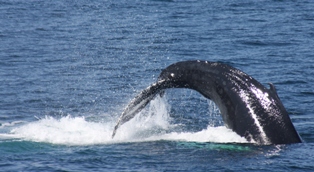
Nazka Kick Feeding
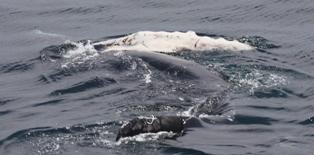
Bolide and Calf Rolling Over
May 13th brought another wonderful day for whale watching, with bright skies, low winds and calm seas. Throughout the course of the trip which, covered much of Cape Cod Bay, we saw 12-18 humpback whales, 1 minke whale, 2 finback whales and 6-10 Atlantic white-sided dolphin! We identified Barb, Buckshot, Compass, Draco, Cosmos, Thumper and calf, Abrasion and calf, Fulcrum and calf and Ganesh and calf. The humpbacks were displaying a wide-range of behaviors from kick and open mouth feeding to breaching, flipper slapping and close boat approaches. Towards the end of our trip we saw Abrasion and her calf do a spinning breach in unison. It is common for breaching to become contagious; once a whale starts others are often soon to follow. Breaching, however, does require a tremendous amount of energy and strength so it is especially impressive to see a humpback calf breach. Today’s trip validated the term charismatic mega-fauna, as the humpback’s wide-ranging behaviors were truly spectacular.
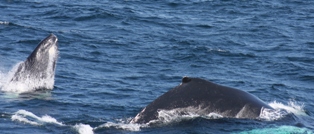
Ganesh and Breaching Calf
On May 14th we left Provincetown harbor and headed towards the South West Corner of Stellwagen Bank. While on route to the bank we sighted so many whales that we only made it to the Coast Guard Station! We had 16+ humpback whale sightings and 100-200 Atlantic white-sided dolphin sightings. We identified Grackle, Ursa, Gumdrop, Ganesh and calf and Springboard and calf, with the remainder of the whales appearing to be unknown juveniles. We observed a myriad of humpback behaviors, including breaching, flipper-slapping, kick feeding, bubble clouds and surface lunges and close boat approaches. Humpbacks have acquired very elaborate feeding strategies such as bubble clouds. When humpback whales find a large school of sand lance they will often try to corral the fish by blowing large bubbles that form “bubble clouds”. These clouds confuse and disorient the fish and in an effort to avoid predation the fish aggregate tightly together, this is a defense mechanism, however, it makes it easier for the whales to catch their prey. Once bubble clouds have formed we will often see the whales emerge with wide-open mouths, scooping up as many fish as possible and trapping them in their plates of baleen.
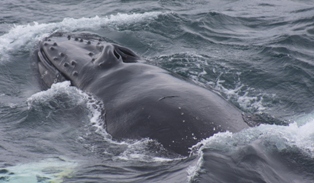
Feeding Humpback
On May 16th we headed for Cape Cod Bay with less than ideal whale watching conditions as fog limited our visibility to a quarter mile. Despite the poor weather conditions, we observed 14-15 individual humpback whales, 2 finback whales and 1 harbor seal! We saw Tapioca, Shoreline, Eruption, Cava, Snare, Tunguska, Wyoming, Tongs and Calf and Dome and her 2008 calf. Once lactation stops, females and their calf will separate on the winter breeding grounds and often will not associate on the feeding grounds. It was therefore interesting to see Dome and her 2008 calf together. The pair appeared to be feeding as they were lunging out of the water on their sides. Lunge feeding is a common foraging strategy observed on Stellwagen Bank. We are interested to see if Dome and her 2008 calf will remain associated throughout the feeding season.
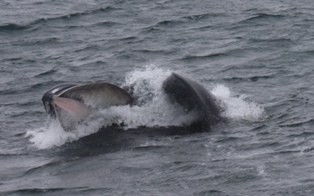
Lunge Feed
We set sail to the South West Corner of Stellwagen Bank on May 17th with rain and gray skies. In spite of the poor weather, we had amazing sightings, with 27-29 humpback whales and 850-1150 Atlantic white-sided dolphins! We identified Mural and calf, Viking, Pregunta, Monarch, Xylem, Pipette, Gunslinger, Abrasion and calf, Tracer, Eruption, Buzzard and Joy. It appeared as though the whales had located a large prey patch close to the surface, as many of the whales were kick feeding and surfacing with open mouths. Humpbacks will adapt their feeding strategies based on where the prey is located in the water column. Kick feeding is often employed when prey is located near the surface, as the force of the whale’s tail stuns the prey making it easier for the whales to trap the fish in their plates of baleen. Although it is almost impossible to confirm whether whales are feeding while below the surface, it is generally thought that long-fluking dives repeated in the same area are indicative of bottom feeding. Towards the end of our trip, Abrasion’s calf became curious of our boat, affording us the ability to closely investigate the 4 month-old whale with great excitement.
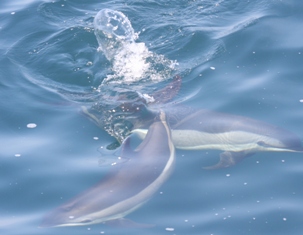
Atlantic White-Sided Dolphins
On May 18th we left Provincetown harbor with light rain and moderate seas. While on route to Stellwagen Bank, we found a large group of 15-30 humpback whales and 3 finback whales. Although humpbacks are solitary animals, unlike toothed whales, they will form short-term associations on the feeding grounds. Humpbacks will sometimes feed on a prey patch cooperatively. For instance, some whales may be below the prey patch releasing bubbles to form a bubble cloud while other whales may be at the surface kick feeding to the stun the prey—collectively the whales are able to catch a greater number of fish. Some of the observed humpbacks appeared to be feeding cooperatively, with bubble nets and kick feeding. We identified Stub, Gumdrop, Fracture, Mars and calf, Crystal, Walrus, Grackle, Filament, Alphorn, Tear, Reflection and calf, Gladiator, Glo and calf, Ganesh and calf and Fulcrum.
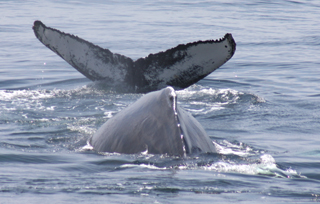
Stub
We sailed out into Cape Cod Bay on May 19th with perfect weather and sea conditions, bright skies and calm seas! While traveling to the South End of Stellwagen Bank we encountered 27-31 individual humpback whales. All but two of the observed whales were feeding, using bubble nets and clouds to disorient the fish and corral their prey into a tight ball. We identified Ampersand, Ursa, Wyoming, Grackle, Gumdrop, Stub, Milkweed, Bolide and calf, Buzzard, Xylem, Zap, Vulture, Orbit, Underline and Gunslinger. In the afternoon we had two unknown humpbacks become curious of our boat, giving us a close boat approach!
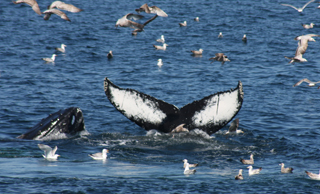
Xylem and Buzzard





